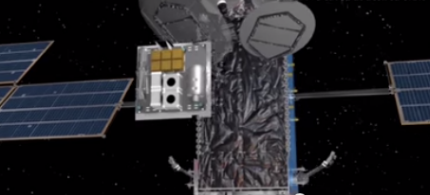Pentagon program would hitch rides with commercial satellites
DARPA’s Phoenix program has released the specs for its plan to launch detachable payloads with commercial communications satellites.
In this frame from a DARPA concept video, a military payload is released from a commercial satellite.
The military has been exploring a number of commercial options to cut the mounting costs of launching and operating satellites, from reusable launch vehicles to hiring out monitoring of a service’s constellation.
Another idea that has been catching on is hosted payloads, in which a small satellite for a military function—say, surveillance—hitches a ride on a commercial satellite, with the government and industry sharing the costs. The Air Force in July awarded a potential $495 million contract to 14 companies (and later added another company) to compete for work under the Air Force’s Hosted Payload Solutions, or HoPS, ride-sharing program.
Under HoPS, however, the military capability would remain attached to the commercial satellite and its orbit. The Defense Advanced Research Projects Agency wants to go one better, with military satellite modules that would depart the commercial craft and go their own way. The Payload Orbital Delivery system, part of DARPA’s Phoenix program, aims to develop a detachable, hosted payload system for satellites in geosynchronous Earth orbit (GEO), about 22,000 miles above Earth.
To help things along, the program has released a document detailing the specifications for the delivery system, which program managers hope will be able to carry a wide variety of payloads into space.
The idea of hosted payloads has been around for years, though government generally has resisted the idea of sharing launches, preferring to launch and operate its own satellites. But budget pressures from Congress combined with the lumbering, expensive process of military launches have caused agencies to reconsider.
Launches of military and other government satellites can cost hundreds of millions of dollars and take years to plan and schedule, DARPA notes. Commercial launches, in contrast, tend to cost less and occur more frequently—in addition to saving money, the military could speed the process of getting satellites in orbit.
Such an approach couldn’t cover everything—Global Positioning System satellites, the next of which will cost about $500 million to build and $300 million to launch, aren’t on the menu—but it could handle smaller payloads. With the Payload Orbital Delivery, or POD, system each POD would be about 1.3 feet by 1.6 feet by 3.3 feet (1 meter) and be able to carry 150 pounds to 220 pounds of equipment, according to DARPA’s specs. Configurations could change depending on the job at hand, but each POD would use a standardized interface for attaching to the host satellite. When the satellite gets to a targeted orbit, the POD would be released.
Hosted payloads are one way the Phoenix program is looking to scale back satellite costs. Another is its plan to develop robotics systems that could repair satellites in space, thereby extending their lives.
